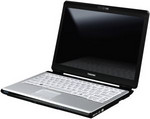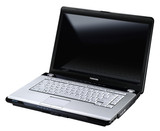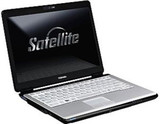Toshiba Satellite Pro U300
Especificaciones de Portátil(es)

Price comparison
Promedio de 1 puntuaciones (de 3 análisis)
Análisis para el Toshiba Satellite Pro U300
Origen: Inside HW
 EN→ES Archive.org version
EN→ES Archive.org versionGenerally, right word that describes this notebook best is average. Nowadays average doesn’t go by very well. None of these faults are too big but there are many of them, much more than we expected. Toshiba Satellite U300-153 with price tag somewhere around 700€ ranks up as cheaper in its class. That is withal its biggest selling point because of reduced offer of 13.3’’ screen notebooks on the market. We consider that you can spend your money wiser if, from any reasons, notebook of these dimensions isn’t necessary.
Preis mäßig
Único Análisis, disponible online, Mediano, Fecha: 07/02/2008
Puntuación: precio: 60%
Origen: Pocket Lint
 EN→ES Archive.org version
EN→ES Archive.org versionToshiba tends to split its business in two quite distinctive trends, you have the full multimedia statements, such as its Qosmio line, and then there is the rather subdued and safe business machine. While the Toshiba Satellite Pro U300 falls into the second camp it's not an unattractive notebook. Finished in black and grey plastic, this isn't the most stylish of notebooks but it certainly proved robust for use on the move. It's a slim machine considering there is a DVD rewriter built-in and the size means it great for the commute, as it will easily slip in to any standard carry case. With an overall weight of 2.1kg, it's reasonably portable and coupled with a battery life well in excess of 3 hours, we were more than satisfied with its portability. The Toshiba Satellite Pro U300 may not be a notebook to grab the headlines like some other 13.3-inch machines but we found it a powerful and versatile machine that certainly offers great value for money.
8 von 10, Leistung gut, Mobilität gut
Único Análisis, disponible online, corto, Fecha: 04/07/2008
Puntuación: Puntuación total: 80% rendimiento: 80% movilidad: 80%
Origen: c't - 4/08

Comparación, , Mediano, Fecha: 01/31/2008
Puntuación: rendimiento: 70% características: 80% pantalla: 40% movilidad: 70% ergonomía: 80%
Comentario
Intel Graphics Media Accelerator (GMA) X3100: Intel Graphics Media Accelerator (GMA) X3100 es un chip de video integrado (incorporado) en un chipset de Mobile Intel 965GM (para Merom =Core 2 arquitectura). Es el sucesor del Intel GMA 950. Lo más interesante es la integración de un pipeline completamente programable. Debido a la integración de características Direct X9, HDR y Hardware Transform & Lighning (T&L) – su predecesor solo tenía Software T&L – debería estar listo para Windows Vista Premium (soporte Aero Glass completamente). Con respecto a los datos, el rendimiento debe ser claramente mejor al de GMA 950.
Muchos juegos son difícilmente ejecutables con estos adaptadores gráficos o se ejecutan de manera muy lenta.
>> Más información puede ser encontrada en nuestra comparación de tarjetas gráficas moviles y la lista de benchmarks.
Intel Core 2 Duo: Este es el sucesor Core Duo y el Core Solo con un pipeline más largo y con una velocidad entre 5-20% sin mayor consumo de energía. Adicional al diseño de Core Duo existe un cuarto decodificador, una unidad SSE ampliada y una unidad lógica aritmética (ALU) adicional.
Sus características son: 2 núcleos (cores), una amplificación de comando de 64-bit EM64T y 2 o 4 MB L2 Cache y 291 millones de transistores, que son acabados en 65nm. Mas allá de esto, todos los tipos soportan técnicas "Execute Disable Bit", SSSE3 (SSE4), Enhanced Speedstep, LaGrande y la mayoría de técnicas de virtualizacion (VT) Vanderpool.
El Core 2 Duo para laptops es idéntico a los procesadores Core 2 Duo para desktops, pero los procesadores para notebooks trabajan con tensiones más bajas (0.95 a 1188 Volt) y un Frontside bus clock (1066 contra 667 MHz). El rendimiento de laptops cuena con una frecuencia de 20-25% más baja que PCs Desktop debido a una frecuencia más baja de Frontside bus y los discos duros más lentos.
T7250:
>> Más información puede ser encontrada en nuestra comparación de procesadores móviles.







